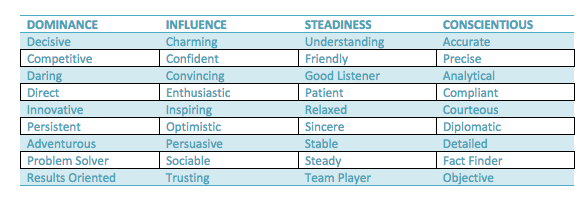ATD Blog
What Would a Marketer Do?
Wed May 15 2019

Bookmark
Corporate training continues to look to the marketing industry for ideas about how to make learning more engaging. The high visibility of marketing and its many touchpoints throughout everyone’s lives makes it a natural reference and source of inspiration. Everyone sees ads and recognizes brand experiences that make an impact on us, and we’d like our learners to be as excited and motivated about our offerings as they are of, for example, popular TV shows.
But where does this cycle start? What’s the process employed by marketers that could help us put these approaches to work for corporate training?
It’s important to note that this is not about money. Many assume marketing departments can create more engaging and effective content because they have large budgets; however, the reverse is the real story. Marketing has a larger budget because what they do is (usually) effective. And the reason it’s usually effective is because of our testing and tracking.
We have larger budgets because we use data and track how marketing impacts behavior.
The effectiveness and budgets and influence are also based on our willingness as an industry to let reality win over lab science. As early adopters of fMRIs, EKGs, and so forth to study the brain in response to stimuli, retention, and neural networks, we also had a head-start on realizing that what happens in a lab or in a self-reported survey rarely reflects how someone acts in daily life. While the research gives insight to leverage, it should never be taken as prescriptive for how to prepare or deliver content. Consider a lab setting versus one’s desk—with the phone ringing, texts coming in, preparing for meetings with your boss, instant messaging via Slack, and hundreds of emails competing for attention while adding stress and anxiety. Research supports that those addressing real-world behavior change are the studies that matter. As training professionals, you are in a position to conduct these real-world tests. Here’s how marketers do it, as a potential guide.
Personas
Before beginning any marketing effort, one question dominates: Who is our audience? While this starts as a demographic question, it quickly progresses to personas. That is—
What problems do they have?
What is their goal?
What motivates them?
Where do they usually go for information?
What’s their decision-making process?
The questions go much deeper; but at a minimum, it is the answers to these questions that drive the rest.
In the process of defining these points, differences usually emerge . . . branches, if you will. This makes sense if you think of something as basic as DiSC assessments or communication styles. While there might not be scientific differences in learning styles, there are real-world differences in how people prefer to operate.
DiSC Characteristics

Source: https://blog.hubspot.com/service/disc-customer-service
With those distinctions, we’ll build out tests leveraging these differences, presenting concepts from different perspectives and tracking what resonates (that is, what results in a behavior, good or bad).
The Journey
As marketers, we’re keenly aware that we have limited time to command people’s attention. It’s a process and once is never enough.
Attention spans primarily pertain to where one chooses to focus attention. With multiple devices competing for our concentration and research showing we switch among devices 21 times per hour, the idea that we can do intense knowledge-transfer in one block is optimistic at best.
Someone is likely to be more engaged in finding and understanding the answer, for example, if they are the one to ask a question. Don’t believe me? I give you one word: Google.
Search engine optimization (SEO) was built around the concept that someone puts a question into the Google search bar and the search engine delivers the best answer to that question. From that, marketers have crafted content that specifically answers questions—and in the way people pose the questions—so that their answers show up as the results. (With YouTube owned by Google, all of this applies there too.)
Marketers refer to these as blogs, infographics, checklists, how-tos, and so forth. Learning professionals probably refer to these as microlearning, job aids, skills checklists, and so forth.
Marketers build paths and further recommendations to build an internal interest or raise an internal question so that engagement is built at the start and internally rather than forced or falsely evaluated based on time spent, likes, or shares. “Those who liked this book/movie/show also liked this recommendation.”
For blog content, marketing automation software helps us track selections and make those recommendations. When the content is written in the context of a bigger plan, we can help people through the plan and provide variations that relate more to what connects to them (think about the DiSC profiles above), which keeps them engaged and curious. In the process, repetition and reinforcement happens as previous concepts are referenced and the spaced repetition is effective in committing concepts to memory.
We don’t try to accomplish everything in one piece of content or present it in one modality or deliver it at one time. We tailor to people’s preferences, give individuals control to decide what they will do next, and monitor if they do what we ultimately want them to do. Knowledge transfer, skill development, behavior change. Sound familiar?
The Results
People have been conditioned by the success of Google and YouTube to expect this sort of presentation that helps them learn or be entertained. Whether disruptive or calming, aspirational or motivating, incorporating emotions is a key piece to any memorable, engaging content.
As this applies to training, we must consider the realities of the world in which our employees exist. If we can manage what someone expects to get out of the training and as it relates to them, helps meet their goals, and helps overcome their challenges, then engagement follows. Put as much time and effort into the learning expectations as you do the learning objectives and engagement will follow.
That’s what a marketer would do.
Want more advice? Join me at ATD 2019 International Conference & Expostion for the session, WWMD? What Would a Marketer Do? We will explore how to apply marketing insights for increased engagement in training offerings.
More from ATD


